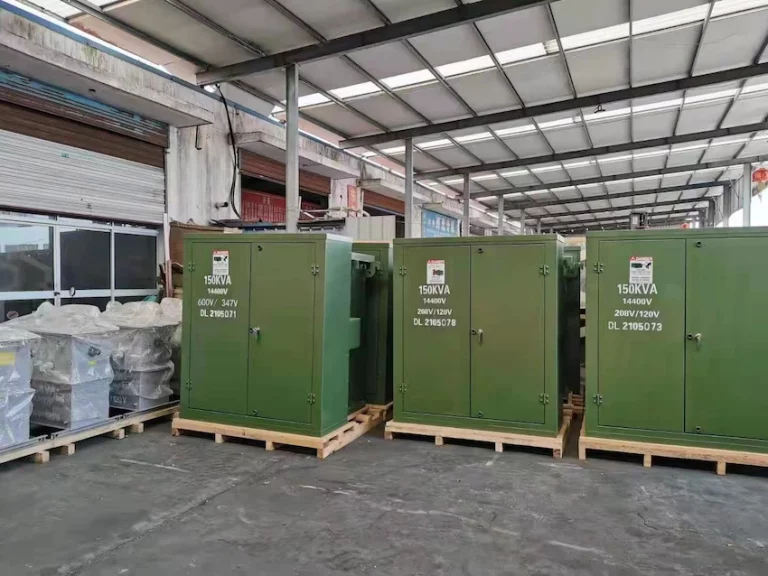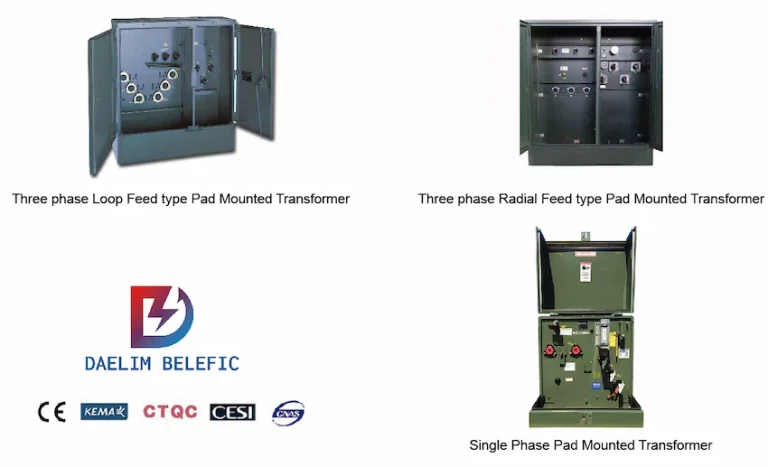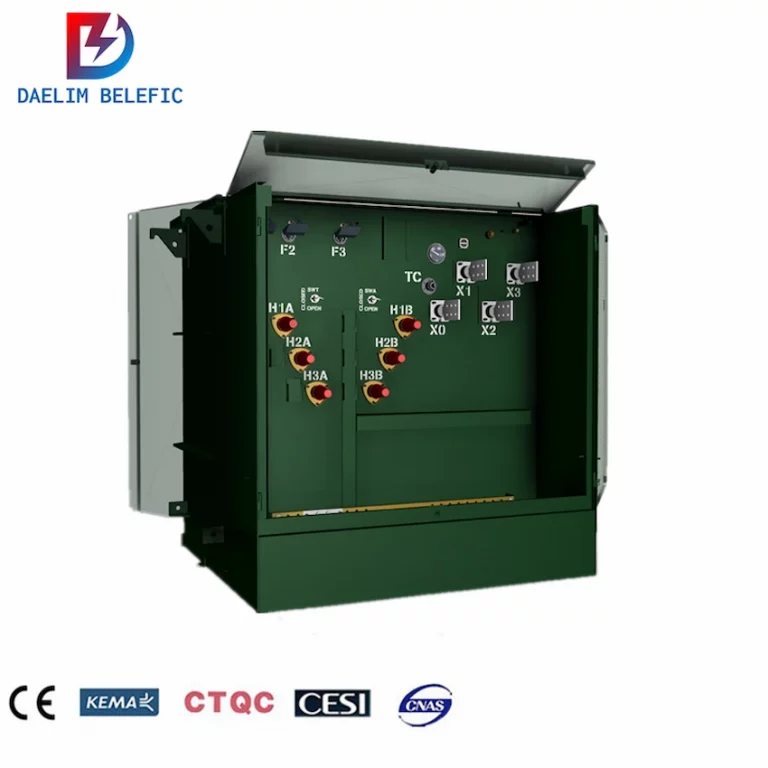ELECTRIC, WITH AN EDGE
Ensuring that safe electrical power levels are reaching end-users is the job of transformers. There are a variety of transformers with different key features, one of which is the live front pad-mounted transformer.
You will be learning what a live front pad-mounted transformer is, how it works, and why you might need one for your homes.
DAELIM is the world’s top professional transformer and electrical equipment manufacturer.
This top-performing transformer and equipment manufacturer has been a reliable and trusted brand for more than 15 years.
Following international standards like ANSI, IEEE, IEC, CSA, AS/NZ, etc., DAELIM upholds these standards with inexpensive, high-quality products.
14+FAQ ABOUT THE PAD MOUNTED TRANSFORMER
-The internal structure and usefulness of the pad-mounted transformer are described in detail. Read on!
1 MVA Three-phase Pad-Mounted transformer 250mva 220kv
-If you’re looking for a professional 1 MVA Three-phase Pad-Mounted Transformer and Power, Daelim can be your best supplier.
A Complete Guide to Single Phase Distribution Transformer
-Consumers use electricity for different industries. Transformers work to make this happen as single phase distribution transformers.
The Complete Guide to Ground Mounted Transformer
-Distribution transformers come in different shapes and sizes. Ground Mounted Transformers are one of the most widely used Pad-Mounted distribution transformers.
A transformer is composed of different parts. Among these parts is an insulator called bushing, which is attached to the innermost core of electric machines.
A bushing is a transducer that allows the safe conduction of electrical transmission between a conductor and a conductive medium.
It also gives rotating parts a bearing surface.
Generally, there are two kinds of bushing — the live front and the dead front.
When a transformer is a live front, it means that the voltage-carrying parts of the bushing are exposed.
You could feel the electricity flowing through it when the transformer is switched on.
Touching a live front transformer could result in electrocution and result in injury or death.

The opposite of live front bushing is the dead front bushing which is fully insulated.
Since the bushing is fully insulated, safety is enhanced, and no voltage-carrying parts are exposed.
The cable and the voltage-carrying components of the bushing are enclosed in molded rubber components. It decreases the risk of electrocution for the operator.
Another advantage of dead-front transformers is the less chance of arc-flash when operators open the cabinets where dead-front transformers are placed.
Arc-flash is a phenomenon when an electric current leaves its natural path.
Instead, the current scatters in the air or even travels to the ground.
When you are close to the arc flash, you can get electrocuted and seriously injured.
A pad-mounted transformer is a type of ground-mounted utility distribution transformer. In most cases, these types of transformers are encased in locked metal cabinets on small concrete pads.
A pad-mounted transformer is installed at service drops.
It allows pad-mounted transformers to step down from primary to the secondary voltage on the utility distribution line.
After the step-down process, the voltage is then supplied to a utility customer.
Although pad-mounted transformers can either be step-up or step-down, most are step-down transformers because they are mainly used for power distribution.
Pad-mounted transformers are more commonly placed in residential subdivisions on consumer properties.
Since they are distribution transformers, pad-mounted transformers provide the final voltage transformation in the electric power distribution system.
Their goal is to step down the voltage in the distribution lines to a safely used level by the end-user.
Pad-mounted transformers can either be single or three-phase designs.
You should know the differences between them to know what is more suitable for your electrical power needs.
Single-phase pad-mounted transformers commonly serve small residential areas and single-phase loads such as traffic signs, signals, and streetlights.
It can step down a utility level of 8,000 to a secondary voltage of 120 or 240 volts. 120 or 240 volts are commonly the voltages used at homes.
For the power to reach the residences, secondary cables are installed from the 120 or 240-volt sides of the transformer.
The cables run underground and reach the consumer’s house.

Three-phase transformers are made by winding together three single-phase transformers into one core. These transformers have a total of six coils, three each on the primary and secondary sides. The primary and secondary sides are separated by 120 degrees of angular difference.
Compared to single-phase transformers, three-phase transformers are encased in larger green metal boxes. These transformers commonly serve industrial and commercial areas that need larger power requirements.
Three-phase transformers can step down utility levels at 13,800 volts to a secondary voltage of 120/208 or 277/480 volts.
Secondary cables are installed from the secondary voltage side of the transformer and then run underground to reach the desired area that needs the power.
A live front pad-mounted transformer is an underground-mounted utility distribution transformer with a live front bushing. This type of transformer is enclosed in an insulated metal housing and secured on small concrete pads.
With live front pad-mounted transformers, they are enclosed in safe metal boxes. In this case, even though their bushings are exposed, they are still considered safe from operators.
Live front pad-mounted transformers are preferred over other transformers because they do not need many land requirements and installation costs.
They also improve the esthetic presentation and safety of an area since they are housed inside metal boxes.
A live front pad-mounted transformer is the transformer of choice for spaces that lack room for fenced enclosures, residential subdivisions, hotels, commercial and industrial areas.
Single-phase pad-mounted transformers are recommended for small areas and equipment such as traffic lights and road lights.
In contrast, three-phase pad-mounted transformers are used for commercial and industrial places that cover larger surface areas.
Pad-mounted transformers used in residential areas are equipped and enclosed in waterproof or water-resistant metal casings.
The metal casings of pad-mounted transformers must be waterproof to resist entry of water or any liquid which can affect the operation of the transformer unit.
The lifespan of transformers is subjective and would depend on the operator, as well as other important transformer factors, including:
Generally, utility distribution transformers like pad-mounted transformers have a lifespan of 75 years. However, this lifespan can still increase or decrease depending on how the aforementioned factors work or affect your distribution transformers. Good handling and operating of these transformers can help in prolonging their lifespan.
Pad-mounted transformers are designed to be safe. However, depending on the operator and owner, neglect and exposure of the transformer to different elements can still affect their safety.
Neglect and improper use of these transformers can cause unfortunate accidents to people. In this case, pad-mounted transformers are safe, but you still need to observe the necessary precautions from these transformers.
If you have kids who like to run and play outside, always give them a heads-up of these transformers. Show them the caution sign on the transformers’ metal boxes so that they are aware too.
Pad-mounted transformers are locked in green metal cases so that utility workers can easily see them. With this, do not attempt to tamper or paint these metal boxes in any way or color.
When you want to connect two transformers on the same circuit, the loop-feed transformer is ideal for this purpose.
A loop feed transformer has two bushings with high voltage per phase line.
It allows the current to loop through the transformer and then down to the next one.
Loop systems are fed by two feeders, which are both connected at each end of the loop.
Loop feed transformers have two high-voltage bushings per phase line connected, so the current can loop through the transformer and then downstream to the next transformer.

The use of electrical transformers is a crucial part of the modern world. They’re essential to our daily lives and help us power our homes, light our buildings and deliver essential services. So you need to understand how electrical power works and how they are lowered at safety levels for your electrical needs.
If you need transformers enclosed in safe casings on secured concrete pads, live front pad-mounted transformers are for you. They can provide electrical power to your residential houses and even larger commercial areas. It is only essential that you learn about what they are and how they work.
At DAELIM, you are guaranteed safe and reliable transformers. These transformers can help you save money and provide you with a quality transformer that will certainly last for years to come.
When you need to find more than just existing transformers, Daelim’s Transformer Service Center can help you design and produce distribution transformers that meet your unique needs.
We have our own factory and a professional team of engineers, which can design and modify application requirements that meet all your conditions.
Download Resource
ELECTRIC, WITH AN ENGE-- DAELIM BELEFIC
After filling in the contact information, you can download the PDF.